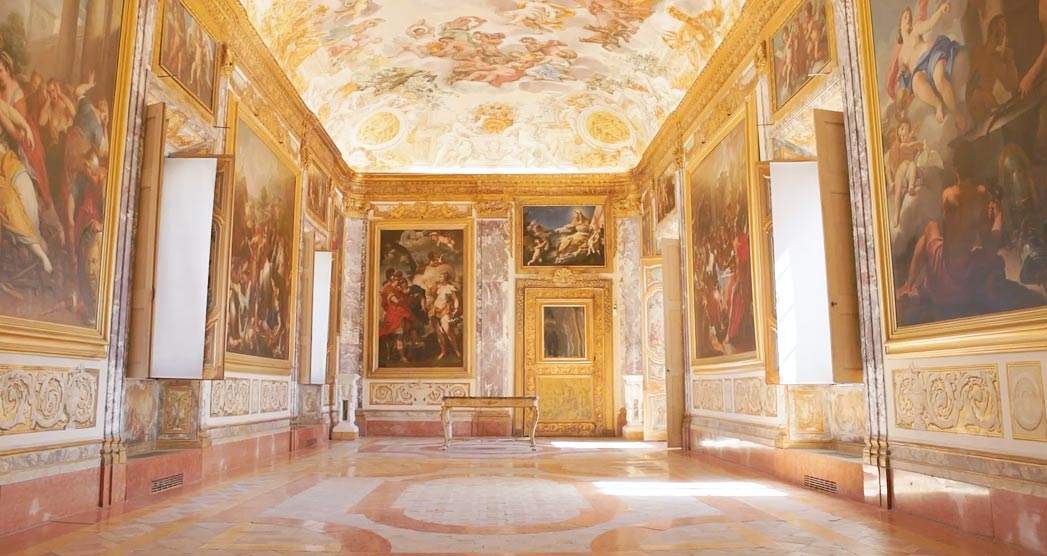Restoration of the main floor of Palazzo Buonaccorsi in Macerata ends, involving one of the city’s most important decorative cycles. The building, now home to the Palazzo Buonaccorsi Civic Museums (which include the civic collection of ancient art, the carriage museum and the “Amedeo Ricci” library), is one of the most beautiful and sumptuous aristocratic residences in the Marche region: it has been owned by the Buonaccorsi family since the seventeenth century, and was built in 1697 to a design by the Roman architect Giovan Battista Contini, who was commissioned by Simone Buonaccorsi to amalgamate a number of previous houses to create a residence befitting his family. The work was completed in 1718 and also saw the creation of the sumptuous frescoed and stuccoed interiors, where the decorations on the walls executed by Antonio Dardani and Carlo Antonio Rambaldi from 1707-1708 and the pavilion vault of the Aeneid Gallery, with the Marriage of Bacchus and Ariadne by Michelangelo and Niccolò Ricciolini executed between 1710 and 1715, stand out. The wall decorations made in the very early eighteenth century at the hands of the Emilian artists Dardani and Rambaldi compose a rich iconographic cycle intended to pay homage to the virtues of the noble Macerata family, passing through mythological scenes that tell us of the exploits of great heroes and gods.
The intervention was presented last Sept. 19 during a press conference by Culture Councillor Katiuscia Cassetta, restorer Maria Topa, municipal manager of Public Works Tristano Luchetti, Carlo Paniccià comumal technician, Giuliana Pascucci of Macerata Musei and Veronica Nespeca of the Santoni firm. The work was carried out by Restauro Dipinti s.a.s. di Topa Maria Pia & C, under the direction of the Soprintendenza archeologica belle arti e paesaggio for the provinces of Ascoli Piceno, Fermo and Macerata. The restoration work was made possible thanks to the teamwork of the municipal Public Works office, which obtained access to the eight per thousand of Irpef directly managed by the state for the category “Conservation of cultural heritage” (Presidential Decree No. 76 of March 10, 1998). Thanks to this funding, earmarked for the reconstruction and restoration of cultural property damaged or destroyed as a result of the August 24, 2016 earthquake, it was possible to carry out the work on the detachments of painted plaster and friezes decorating the upper part of the walls, in each of the large halls of the main floor and in the vault of the Aeneid Gallery. The restoration work was documented in the video made and promoted by the Santoni company, which has chosen to support the cultural projects of the Civic Museums of Palazzo Buonaccorsi since 2020, and which also supported the video clip with the animation of the Olympus depicted in the vault of the Gallery by director Rino Stefano Tagliaferro.
The need for the restoration work stems, as mentioned, from the well-known seismic events of 2016 that caused damage to the decorative apparatus of the palace’s main floor. In the Aeneid room, the strong movements suffered by the camorcanna structure had compromised, in many places, the adhesion between painted plaster and support and the reopening of cracks already restored in the 2008 interventions. The work just completed had as its main objective the restoration of perfect adhesion between painted plaster and support, an operation essential to the conservation of the work depicting the Marriage of Bacchus and Ariadne by the Roman painter Michelangelo Ricciolini and his son Niccolò. Ricciolini repurposed the compositional scheme reminiscent of that of the vault of the gallery of the Orsini Barberini palace in Monterotondo, with a painted parapet above the actual walls, adorned with numerous figures and decorations, including four large medallions in the corners with mythological stories, framing a sky in which the innumerable deities stand out. The light colors, abundance of decorations, and variety of inventions make this vault a significant example of the skill of the Roman painter trained at the school of Maratta and much appreciated by Roman patrons.
The friezes of the rooms on the main floor of the palace, painted by the Bolognese Dardani and Rambaldi, are made with the fresco and mezzo fresco technique; a painting technique that differs from that of the vault of the Aeneid, which is instead in tempera. The major difference is the medium by which the pigments are fixed to the plaster. In the case of fresco painting, the painting is made on a plaster that is still fresh, and the chemical process established between the lime and the carbon dioxide in the air fixes the colors permanently; the tempera technique involves the use of powdered pigments diluted in water and fixed with organic substances of various kinds. The different painting techniques make the main floor even more interesting. However, even in this case, seismic movements had caused detachments of the plasterwork resulting in the loss of the fresco, especially in the frieze parts located above the door and window openings. In this case, the consolidation of the plaster to the support had already been carried out during the emergency intervention in November 2016, but the friezes had many gaps due to the falling painted matter. Therefore, the gaps were filled in and the plasterwork was retouched to restore continuity of reading to the valuable friezes on the piano nobile.
 |
| Macerata, restoration of the sumptuous main floor of Palazzo Buonaccorsi completed |
Warning: the translation into English of the original Italian article was created using automatic tools. We undertake to review all articles, but we do not guarantee the total absence of inaccuracies in the translation due to the program. You can find the original by clicking on the ITA button. If you find any mistake,please contact us.